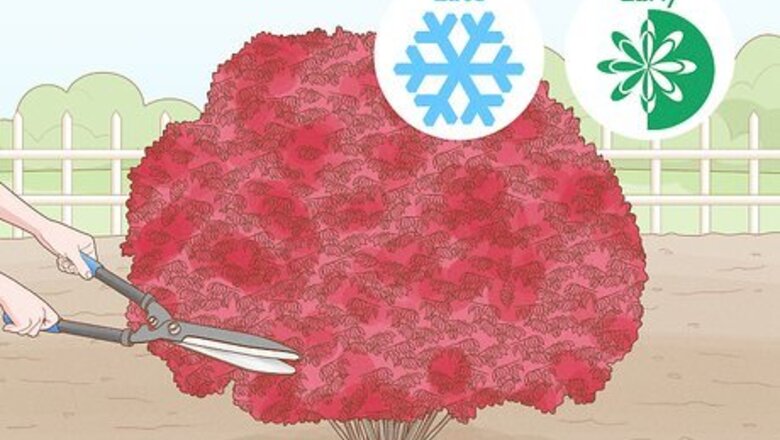
views
Pruning for Plant Health
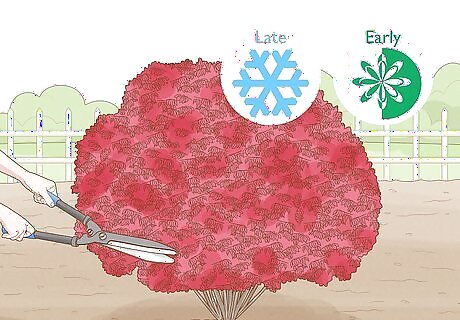
Prune in late winter or early spring. Pruning done only for the health of the plant should be scheduled for the late winter or early spring, before new growth has had much chance for development. Since burning bushes are primarily grown for their foliage, you don't need to worry too much about accidentally removing flower buds. The most vibrant foliage will grow on new branches, though, so it is still best to trim the bush before new growth has developed. When you decide to prune a burning bush for the health of the plant alone, you only need to worry about removing branches that could encourage disease to spread through the plant and destroy it. Even if you opt to prune the plant for shape, you should still prune it for health before worrying shape maintenance.
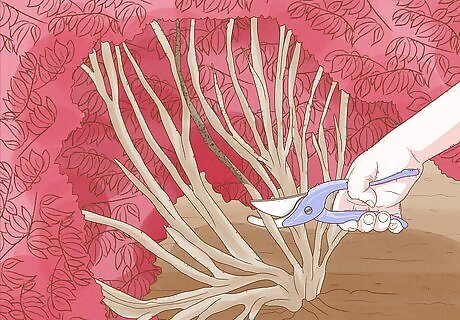
Remove dead or dying branches. Use pruning shears to cut away any dead branches or branches that have been severely injured. Branches are most often injured by disease, insect infestation, animals, or bad weather. Cut diseased branched down to their point of origin on the main stem. Doing so is the only way to make sure that the disease does not spread. Injured branches can be cut back to their point of origin on the main stem, or you may wish to only cut away the injured portion of the branch. In the latter case, cut the injured branch down to a side branch and make the cut 1/4 inch (6 mm) above the bud.

Cut away branches that rub together. Look for any branches or branch stubs that are intertwined or rubbing against each other. Use pruning shears to remove these branches, as well. Cut these branches down to their point of origin on the main stem. Problem branches like these will typically grow back again in the same direction, so it is best to remove them completely instead of trimming them down.
Pruning for Shape
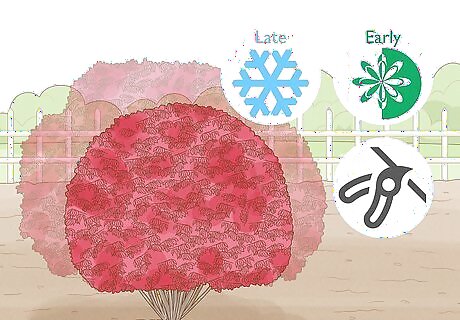
Schedule the initial pruning in late winter or early spring. When pruning a burning bush for shape, you will likely need to schedule two pruning sessions each year. The first one should be before new growth has developed, which means pruning the bush in late winter or early spring. Burning bushes tend to get large and unruly as they mature, but you can usually keep them in check by pruning them down into a desired shape. This type of pruning will keep the bush looking nice for the season while preventing it from completely taking over the space it occupies. When pruning a burning bush for shape, you must also do some pruning for health maintenance.

Decide on a shape. You can choose to trim the burning bush down while maintaining its natural shape or you could trim it down into an ornamental hedge shape. Consider pruning the bush into a standard cube, box, or globe hedge shape. Another option would be to trim out the lower branches, leaving only a rounded top behind. Doing so would make the burning bush look like a small tree. If you have difficulty visualizing your ideal shape, find a photograph or sketch to work from. You could also make your own sketch to help guide you through the process.
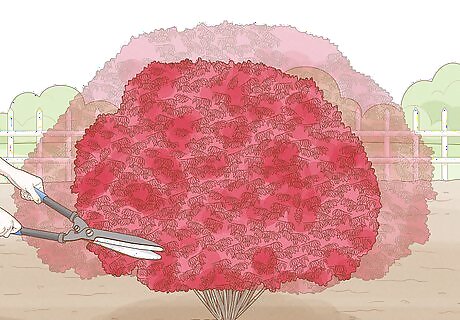
Trim the branches down to that shape. Once you have visualized the shape your burning bush should be, use hedge clippers to remove any branches that extend beyond that shape. When shortening a branch or twig, cut it back to point that is 1/4 inch (6 mm) above a bud or side branch. Unless you choose to completely remove the bottom half of the bush, you should make the top of the bush slightly thinner than the bottom. Doing so will permit sunlight to reach all the leaves of the shrub. A wide top can prevent sunlight from reaching the bottom in adequate amounts, though, causing the plant to become unhealthy.

Thin out some interior branches. When you prune burning bushes into hedge shapes, you should also thin out some of the dense interior branches to improve the spread of air and sunlight through the plant. Remove the oldest, tallest branches completely by cutting them back to their point of origin on the main stem. If you want to redirect inward growing branches so that they grow outward and make the bush less dense, use pruning shears to cut those inward growing branches down to an outward facing bud or branch.
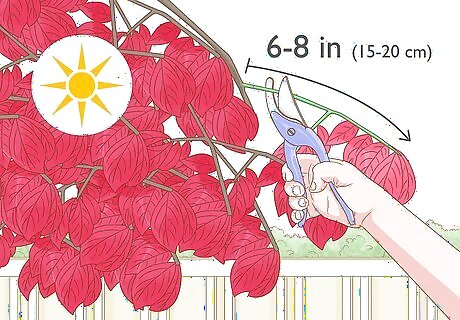
Prune new growth back later in the season. To maintain the right shape, you should prune the burning bush again in the middle of summer. Burning bushes are usually grown for their autumn foliage, so you don't need to worry about accidentally removing flower buds when you do a summer pruning. To determine a more exact time for your summer pruning, wait until new growth reaches a length of 6 to 8 inches (15 to 20 cm). You should prune down new growth within 2 inches (5 cm) of your spring pruning.
Rejuvenation Pruning
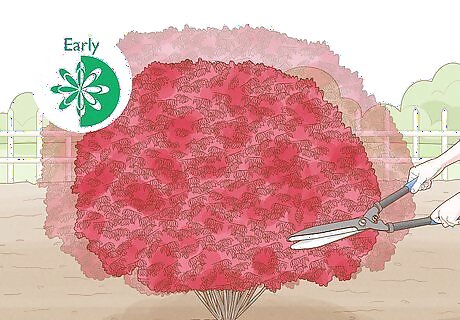
Plan on pruning around early spring. Rejuvenation pruning is the most severe form of pruning. It is best to do this type of pruning in the late winter or early spring, too, since new growth will be forming shortly thereafter, making it easier for the plant to recover. This type of pruning should only be done if the burning bush has become severely overgrown or sickly. A healthy burning bush should be able to grow back vigorously after a severe pruning. You may need to repeat this practice every year or every other year until all of the thick, overgrown trunks are gone. Once you are only left with thinner stems, you can let the bush grow to its desired height and maintain it with regular health or shape pruning.
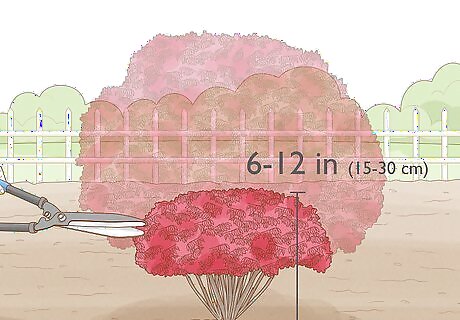
Cut the bush down to ground level. Use hedge shears to cut all of the branches down until they rise no more than 6 to 12 inches (15 to 30 cm) above the ground. When cutting the entire bush down, make sure that you leave at least 1 to 3 inches (2.5 to 7.6 cm) above the ground. Make sure that the cuts are clean and sharp to improve the likelihood of the bush making a full recovery.
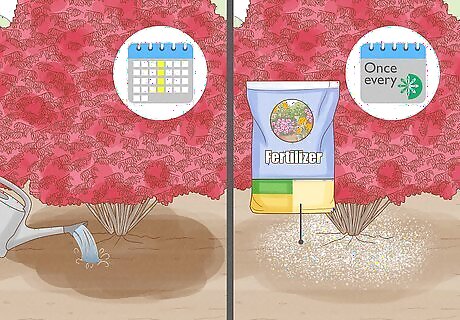
Feed and water the bush thoroughly throughout the season. Since this pruning method is so severe, you will need to pay extra attention to the bush during the first growing season after you prune. Water the plant regularly and apply an appropriate fertilizer. Water the burning bush once a week during the first spring and summer. Give it water in the morning (before the full sun of afternoon hits) and make sure that the soil beneath it is thoroughly saturated. Apply fertilizer once in the early spring, shortly after you prune the bush, and a second time in the late summer or early fall, roughly two months before you expect a first frost to strike. Select a fertilizer that is high in nitrogen and follow the label instructions to determine the proper application method.




















Comments
0 comment